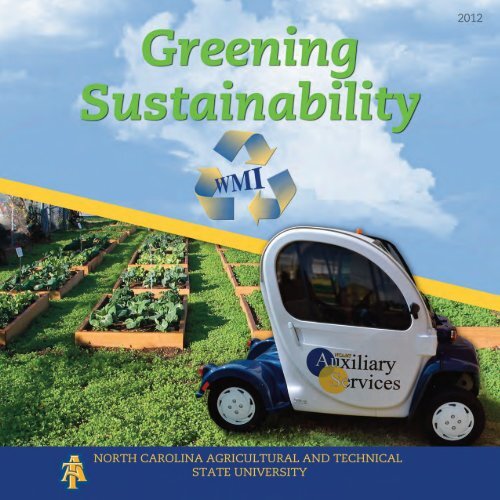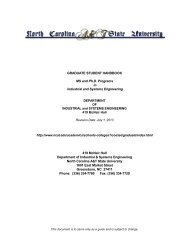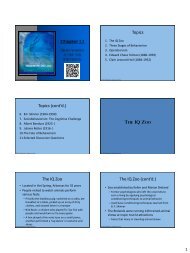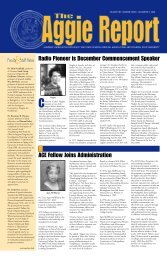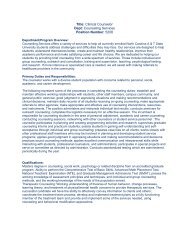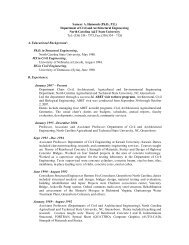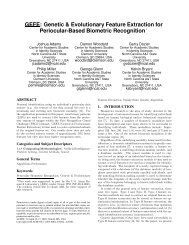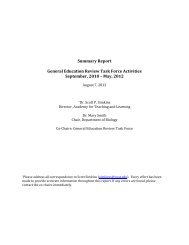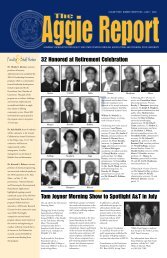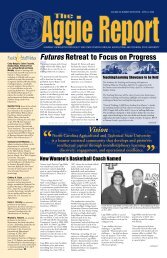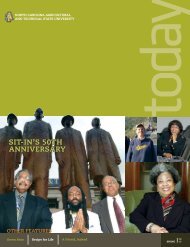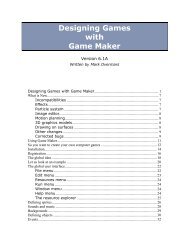Greening Sustainability Brochure - North Carolina A&T State ...
Greening Sustainability Brochure - North Carolina A&T State ...
Greening Sustainability Brochure - North Carolina A&T State ...
Create successful ePaper yourself
Turn your PDF publications into a flip-book with our unique Google optimized e-Paper software.
Preface<br />
<strong>North</strong> <strong>Carolina</strong> Agricultural and Technical <strong>State</strong><br />
University has a history of providing leadership in<br />
addressing environmental sustainability issues<br />
through interdisciplinary centers, institutes and<br />
academic programs at all degree levels. These<br />
interdisciplinary collaborations have made the<br />
University a major contributor to understanding<br />
sustainability on a global scale.<br />
N.C. A&T has taken advantage of the Higher Education<br />
<strong>Sustainability</strong> Bill (The Higher Education Opportunity<br />
Act-P.L. 110-315) signed by President George W. Bush in<br />
2008. In March 2011, Chancellor Harold L. Martin Sr.<br />
launched a robust recycling program and encouraged<br />
everyone to recycle. The goal of the recycling program<br />
is to improve the quality of life now and in the future.<br />
The university’s sustainability programs are<br />
highlighted by natuculture-biomimicry, constructed<br />
wetlands, aggies recycle, recycling audit, bio-energy<br />
and bio-fuel production, sustainable buildings,<br />
sustainable transportation, trayless dinning, climate<br />
change and hazmat training.<br />
Godfrey A. Uzochukwu, PhD<br />
Professor and Director, Interdisciplinary Waste<br />
Management Institute<br />
2<br />
Contents<br />
Preface ....................................................................2<br />
Message from the Chancellor ........................3<br />
UNC-Tomorrow ....................................................4<br />
Green Institutes, Centers and Programs ....5<br />
Natuculture – Biomimicry ................................6<br />
University Farm ....................................................8<br />
Green Paw Aggies ..............................................9<br />
Constructed Wetlands ......................................10<br />
Aggies Recycle ....................................................12<br />
Recycling Audit ....................................................13<br />
Bio-Energy..............................................................14<br />
Bio-Fuels ................................................................15<br />
Sustainable Buildings ........................................16<br />
Sustainable Transportation..............................17<br />
Environmental Recyclable Purchasing........18<br />
Trayless Dining......................................................19<br />
Hazmat Training ..................................................20
Message from the<br />
Chancellor<br />
<strong>North</strong> <strong>Carolina</strong> Agricultural and Technical <strong>State</strong> University is an important intellectual<br />
and cultural center in the Piedmont Triad community, and it contributes significantly<br />
to improving the quality of life for citizens of <strong>North</strong> <strong>Carolina</strong>, the nation and beyond.<br />
Institutions of higher learning play an important role in promoting sustainability<br />
practices. At N.C. A&T, our students are trained to plan for a sustainable future through<br />
practices that become a way of life.<br />
At A&T, we have invested in cutting-edge sustainable activities that aim to improve<br />
quality of life as well as protect the environment. We also have focused on creating<br />
environmentally sustainable operations, such as the use of electric cars, energy<br />
conservation, water conservation, recycling (and using recycled products), electronic<br />
purchases, electronic mailing, and complying with <strong>North</strong> <strong>Carolina</strong>'s sustainable<br />
reporting requirements.<br />
Our university has embraced sustainability as a core value. This report summarizes our<br />
efforts and accomplishments.<br />
Harold L. Martin Sr., PhD<br />
Chancellor<br />
3
UNC-Tomorrow<br />
Environmental<br />
<strong>Sustainability</strong><br />
“…<strong>North</strong> <strong>Carolina</strong> A&T <strong>State</strong> University (N.C. A&T) is a learnercentered<br />
community that develops and preserves intellectual<br />
capital through interdisciplinary learning, discovery, engagement,<br />
and operational excellence. The University is committed to<br />
fulfilling its fundamental mission through exemplary<br />
undergraduate and graduate instruction, scholarly and creative<br />
research, and effective public service. The UNC-Tomorrow<br />
initiative presents many opportunities for N.C. A&T to achieve<br />
these goals…”<br />
In the UNC-Tomorrow Phase II Response Plan, N.C. A&T identified how to implement the key<br />
priorities in the context of the Commission’s Major Findings and Recommendations. The<br />
context addressing environmental sustainability challenges that <strong>North</strong> <strong>Carolina</strong> faces now<br />
and in the future. To effectively respond to the present and future needs of <strong>North</strong> <strong>Carolina</strong>,<br />
N.C. A&T is committed to maintaining and increasing high academic standards, the quality<br />
of its degree and research programs, and adding new academic degree programs to ensure<br />
graduation of well-educated students prepared for the competitive global economy.<br />
4<br />
UNC-Tomorrow Report
Green Institutes, Centers and Programs<br />
Godfrey A. Uzochukwu, PhD<br />
Professor and Director<br />
Interdisciplinary Waste Management Institute<br />
WMI<br />
CERT<br />
The Interdisciplinary Waste Management Institute (WMI)<br />
The WMI was established in 1994 as an interdisciplinary academic support unit with<br />
research and public service functions. The purpose of the WMI activities is to enhance<br />
awareness of environmental and sustainability issues needed to improve the quality of<br />
life and protect the environment. The institute offers undergraduate and graduate<br />
certificate programs in waste management, organizes national environmental<br />
conferences, advises students who are interested in environmental and waste<br />
management careers, provides scholarships to students and helps coordinate<br />
environmental and waste management instruction, research, outreach, internships,<br />
faculty development, and student development that exists in individual departments.<br />
The effectiveness of the WMI is specifically assessed through: the number of students<br />
receiving WMI certificates, the number of partnerships established, the number of<br />
funded scholarships awarded, and the number of lecture series and invited guest<br />
speakers.<br />
The Center for Energy Research and Technology (CERT)<br />
CERT was established in 1984 and approved by the UNC System as a Center in 2001. It<br />
works with the <strong>State</strong> Energy Office and its activities include research, outreach and<br />
extension, and education with an emphasis on underrepresented populations. As<br />
buildings are responsible for almost half of the energy use in the <strong>State</strong>, CERT’s goals<br />
include facilitating the application of energy-related technologies to buildings,<br />
collaborating with the building industry, and developing University-wide relationships<br />
with the public and the private sectors. The effectiveness of CERT is specifically assessed<br />
through the number of students receiving training in energy-related areas.<br />
5
NOAA ISETCSC<br />
EES<br />
National Oceanic and Atmospheric Administration (NOAA)<br />
Interdisciplinary Scientific Environmental Technology<br />
Cooperative Science Center (ISETCSC)<br />
The mission of ISETCSC is to develop capacity in research in NOAA’s scientific areas<br />
within N.C. A&T and six partner institutions (including NCSU) to be able to train<br />
undergraduate and graduate students in NOAA’s scientific areas and increase public<br />
awareness through K-12 summer camps and teacher workshops. Its overall goal is<br />
technology development for understanding climate and environmental change. The<br />
primary objective of ISETCSC is producing underrepresented doctoral students in<br />
NOAA’s scientific areas. The effectiveness of the ISETCSC is specifically assessed<br />
through: the number of students receiving training in NOAA’s sciences; the number of<br />
graduates in NOAA sciences; career success of graduates; number of collaborations<br />
with NOAA scientists; leveraging of NOAA funding and; relevance of the research to<br />
the needs of NOAA.<br />
Energy and Environmental Studies (EES) PhD Program<br />
The EES PhD faculty research advisers for the students come from the College of Arts<br />
and Sciences, School of Agriculture & Environmental Sciences, College of Engineering,<br />
School of Business & Economics, and School of Technology. The program is training<br />
interdisciplinary leaders in global energy and environmental issues. This is an effort<br />
to increase the number of underrepresented professionals and educators, especially<br />
African Americans, available to work in the energy and environmental fields.<br />
6
Natuculture - Biomimicry in Urban Landscapes<br />
Manuel Reyes, PhD<br />
Professor, Bio Engineering Program<br />
Natuculture (pronounced ná-chew-culture), a term originating from <strong>North</strong> <strong>Carolina</strong> Agricultural<br />
and Technical <strong>State</strong> University (N.C. A&T), is any human-made system that mimics nature in human<br />
disturbed landscapes. The term is derived from ‘nature culture.’ Since 2008, multigenerational teams<br />
of students from different disciplines have been designing and implementing natuculture systems on<br />
the campus of N.C. A&T. Students converted a portion of a conventional lawn – which we call a ‘drugaddicted<br />
carpet’ that has very limited utility – into a natuculture system. Now the landscape at this<br />
site near the N.C. A&T football stadium, is a vibrant, biologically diverse, multifunctional and<br />
ecologically complex system. Features of the system include a green roof, a rain garden, a rainwater<br />
harvester, a solar powered bird pond, bird feeders, and at least 50 species of flora. It is visited by an<br />
array of birds, including American gold and red finches, titmice, <strong>Carolina</strong> chickadees, mourning doves,<br />
hawks, downy wood peckers, and cardinals. Other fauna, insects and arthropods that feed at the site<br />
include bumble bees, spiders, butterflies, squirrels and a ground hog named ‘Arnold.’<br />
In addition, following the example of First Lady Michelle Obama, 32 six-by-three foot raised vegetable<br />
beds, which we call “oasis sofas,” were established. The purpose of the oasis sofas is to demonstrate<br />
and research ways to bring nutritional food into home deserts using very limited space. A home<br />
desert is defined as a household whose diet barely contains nutritious food. The oasis sofa is a<br />
scientifically replicated study that compares conservation agriculture with conventional methods to<br />
produce vegetables in urban areas. Conservation agriculture mimics a forest the ecosystem, and the<br />
practice has been shown to double yield, be eco-friendly, sequester carbon, improve soil and water<br />
quality, arrest erosion, save on fossil fuel and labor, and significantly decrease use of artificial<br />
chemicals by providing natural fertilizers. Graduate and undergraduate students have been<br />
monitoring and will write scientific papers about soil quality, yield, artificial fertilizer use, biomass,<br />
carbon sequestration, profit, and many other variables in the oasis sofa study. This study is also an<br />
excellent tool that exposes students to the benefits of healthy living.<br />
7
Natuculture has spread beyond the N.C. A&T<br />
campus. Partnerships have been and are being<br />
developed with five K-12 campuses and also with<br />
a health care facility for the underserved. The<br />
partners are General Greene Elementary School,<br />
Aycock and Neal Middle Schools, Dudley and<br />
Southern High Schools, and CAARE, a non-profit<br />
organization that promotes a holistic and<br />
community approach to health and seeks to<br />
address disparities in health care access. Most of<br />
these campuses are underserved with<br />
predominantly African-African and Hispanic<br />
populations.<br />
Natuculture can be a transition for permaculture. When several natuculture systems stably synergize,<br />
the site is transformed into a permaculture system. ‘Permaculture is the conscious design and<br />
maintenance of agriculturally productive ecosystems which have the diversity, stability, and resilience<br />
of natural ecosystems. It is the harmonious integration of landscape and people — providing their<br />
food, energy, shelter, and other materials and non-material needs in a sustainable way. The<br />
philosophy behind permaculture is one of working with, rather than against nature; and of protracted<br />
and thoughtful observation rather than protracted and thoughtless action<br />
(http://permaculture.org.au/what-is-permaculture/).<br />
Thanks are extended to the Environmental Protection Agency’s People, Prosperity, and Planet (P3)<br />
student design contest, which triggered this idea and provided funding for students to carry out<br />
designs and compete nationally, and to the United <strong>State</strong>s Department of Agriculture (USDA)-Natural<br />
Resources Conservation Service for supporting student scholars who acted on this idea. Additional<br />
support was provided by the USDA-National Institute of Food and Agriculture 1890 Capacity Building<br />
and Evans-Allen Formula grants, concepts in conservation agriculture were learned from a United<br />
<strong>State</strong>s Agency for International Development SANREM-CRSP project in Southeast Asia, and technical<br />
expertise was provided by NC <strong>State</strong> University and N.C. A&T Cooperative Extension.<br />
8
9<br />
The<br />
University<br />
Farm<br />
Farm Manager Leon Moses<br />
is inspecting hay that is<br />
stored at the farm. The notill<br />
farm produces its own<br />
hay throughout the regular<br />
cropping season to feed our<br />
animal herds of sheep,<br />
goat, beef and dairy cows<br />
during winter months. The<br />
farm also grows cover<br />
crops on all land that is<br />
used for corn, soybean and<br />
wheat.
Green Paw Aggies – Campus Environmental<br />
Leadership Group<br />
Ashley Wade<br />
Civil/Architectural Engineering Senior<br />
President, Green Paw Aggies<br />
Green Paw Aggies is a new student organization<br />
on campus that helps <strong>North</strong> <strong>Carolina</strong> A&T become more<br />
sustainable and reduce the carbon footprint. Green Paw<br />
Aggies was previously under the umbrella of ASABE<br />
(American Society of Agricultural and Biological Engineers).<br />
One of the main objective of Green Paw Aggies is to serve as<br />
a collection pool for all environmental and sustainable<br />
issues on campus. The primary responsibilities of Green<br />
Paw Aggies include but are not limited to:<br />
• Developing the next generation of “Green” leaders and increasing the base of<br />
students calling for sustainable changes<br />
• Serving as an educational tool for N.C. A&T and surrounding communities for<br />
issues dealing with sustainable changes and green economic development<br />
• Promoting and coordinating eco-friendly and economic sustainability goals and<br />
initiatives for the campus and the surrounding community<br />
• Creating and upholding a collaboration between students, student<br />
organizations, faculty and staff.<br />
10
Constructed Wetlands<br />
G.B. Reddy, PhD<br />
Professor, Natural Resources and Environmental Design<br />
Animal production which is<br />
vital for protein demand and<br />
the economy is one of the<br />
regulations. Constructed wetlands have<br />
been used or at least investigated for<br />
treatment of animal waste in the United<br />
major components of United <strong>State</strong>s<br />
<strong>State</strong>s and around the world. Constructed<br />
agriculture. Animal production brings along wetlands are cost- effective, passive, easy to<br />
a baggage of waste production and<br />
operate, efficient in nutrient removal,<br />
environmental problems. These problems flexible in soil specificity, and<br />
are related to odor, pathogens,<br />
environmentally friendly. Even though<br />
concentration of nutrients, and limited land constructed wetlands have been proven in<br />
availability for treatment. Particularly in the nutrient removal, it could be a challenge to<br />
swine industry, large swine production<br />
treat highly concentrated swine wastewater<br />
occurs in confinement and generates large and to understand the function through its<br />
quantities of waste in a limited per-unit<br />
physical, chemical, and biological processes.<br />
area. Traditionally, swine operations in<br />
<strong>North</strong> <strong>Carolina</strong> A&T <strong>State</strong> University<br />
many parts of the world flush the waste<br />
received approximately $20,000 from the<br />
from swine houses into an anaerobic lagoon Army Core of Engineers to construct<br />
and from there the lagoon water is applied wetlands at the swine unit on the<br />
on the land for treatment. In many places, University Farm. Six marsh-pond-marsh<br />
the limited land and continuous<br />
constructed wetland cells (44 m length and<br />
applications of wastewater pose a threat to 11m width) were designed in 1995. Each cell<br />
the surface and ground water quality.<br />
had a 20 m middle pond section and 10 m<br />
marsh section at the influent and effluent<br />
The constructed wetlands can be a pre-<br />
ends. Shallow sections with marshes at the<br />
treatment technology before land<br />
influent and effluent ends and deep section<br />
application to reduce water quality<br />
in the pond had an operating water depth of<br />
pollution and to meet environmental<br />
15 cm and 75 cm, respectively. The marsh<br />
11
sections were planted with cattails and<br />
bulrushes in March 1996. Later in 2004, the<br />
two cells were converted into complete<br />
marsh. Several years of research was<br />
conducted in cooperation with the USDA-<br />
ARS station scientists at Florence, SC to<br />
understand the wetland system in removal<br />
efficiency of nutrients and pathogens. With<br />
our experience, we learned that these<br />
wetlands are efficient in removing nitrogen<br />
and partial removal of phosphorus and<br />
pathogens. We understood the bacterial<br />
communities and their functionalities in<br />
nutrient removal. In essence, swine<br />
operators can use constructed wetlands as<br />
pre-treatment before land application to<br />
reduce the excess accumulation of<br />
phosphorus in soil and reduce water<br />
pollution.<br />
Apart from our research activities, these<br />
wetland facilities were used for teaching<br />
undergraduate and graduate students. Also,<br />
these facilities are visited year round by<br />
school children to see the wetland<br />
ecosystem and bird watch.<br />
12<br />
Dr. G.B. Reddy
Aggies<br />
Recycle<br />
Reduce Reuse Recycle<br />
PLEASE RECYCLE...<br />
Plastic Bottles<br />
Cans<br />
Jugs<br />
Aerosol Cans<br />
Glass<br />
Dry Paper<br />
Food Cans<br />
Buckets<br />
13<br />
Co-Mingled<br />
Recycling<br />
Commingled Recycling<br />
refers to the disposal of<br />
recyclable materials that<br />
can be disposed of into the<br />
same recycling container.<br />
Aluminum, Plastic, Paper<br />
and Glass can go into<br />
these containers in an<br />
environmentally safe<br />
manner.<br />
Crates<br />
Magazines
Recycling Audit<br />
Joseph Fisher, Jennifer McClendon, Lucas Suarez, Quazi<br />
Rahman, Ashley Wade and Genero Perez-de Leon<br />
The purpose of a recycling audit is to determine containers needs, proper and improper use. The audit<br />
involves visual inspection of materials, interviews, data collection, and assessment.<br />
Objectives<br />
• Assess the functionality and efficiency of the recycling bins<br />
• Discern the reasons behind improper usage of the recycling bins<br />
• Promote awareness about recycling bins<br />
• Encourage proper usage of recycling bins<br />
• Find ways to make the idea of recycling more appealing to the student body<br />
On-site activities<br />
1. Entrance Briefing<br />
2. In-depth Interviews<br />
3. Visual inspections<br />
4. Examine records<br />
5. Record site observations<br />
Post audit activities:<br />
1. Detailed Information Analysis<br />
2. Preparation of Draft Audit Report<br />
3. Review of Draft Report<br />
4. Final Audit Report with Corrective Action Plan<br />
Sample Questionnaire<br />
1. Did you know that we have recycling bins on campus?<br />
2. Do you use them often?<br />
3. Why or why not?<br />
4. What goes in the recycling bins on campus?<br />
5. Have you ever put a “non-recyclable” in the recycling bin?<br />
6. If you see someone else putting a “non-recyclable” in the bin, would you correct them?<br />
7. Why or why not?<br />
8. If you could change something about the bins, (i.e the look, location, etc.) what would you change?<br />
9. How can the University make recycling more appealing to the students?<br />
10. What can the students do to encourage more awareness about recycling on campus?<br />
14
Bio-energy<br />
Abolghasem Shahbazi, PhD<br />
Professor, Natural Resources and Environmental Design<br />
15<br />
Mission<br />
To serve as a resource in energy<br />
education and research in the<br />
state of <strong>North</strong> <strong>Carolina</strong> and the<br />
South East region, in the field of<br />
biological and thermochemical<br />
conversion of biomass to bio-fuels<br />
and by-products.<br />
Production of Bio-fuel from Agricultural Wastes<br />
In 2011 we produced 13 billion gallons of ethanol from corn crop. We need to produce 20 billions<br />
gallons more ethanol in the next 10 years from crop residues and woody biomass instead of corn.<br />
We have a well equipped fermentation lab in JSNN and a gasification facility at the A&T farm for<br />
converting crop residues and woody biomass to ethanol.<br />
Production of ethanol from cellulosic biomass such as crop residues is both sustainable and<br />
environmentally friendly. Using such fuels can improve our air quality and enhance our energy<br />
independence.
Bio-fuels<br />
Harith K. Rojanala<br />
Graduate Student<br />
Thermal Degradation Characteristics of Biomass in<br />
the Presence of Air, CO 2 and N 2<br />
The objectives of this research are to investigate the chemistry of biomass gasification and the<br />
reactive gas-particle flow behavior in a fluidized bed gasifier, and to advance biomass gasifier design<br />
and operation.<br />
Gasification has already been proven as a robust technology that can be used to convert a low value<br />
and highly distributed solid biomass such as forest, agricultural and organic processing residues to a<br />
uniform gaseous mixture, by heating the<br />
biomass in a gaseous medium such as<br />
air, steam and oxygen.<br />
The product gas can be further used as<br />
an industrial feedstock for heat and<br />
power generation, H2 generation and<br />
synthesis of liquid fuels. A Thermo<br />
Gravimetric Analyzer (TGA) has been<br />
used as an ideal gasifier in order to better<br />
understand the gasification process. The<br />
TGA measures the changes in weight of a<br />
sample as a function of temperature and time, under controlled<br />
atmosphere.<br />
16
Sustainable Design, Operation, Construction and<br />
Maintenance<br />
Buildings account for 40% of the energy and 72% of the electricity used in the United <strong>State</strong>s.<br />
They account for 16% of the total U.S. water consumption, 40% of all material flows and<br />
produce up to 40% of the waste in landfills, depending on the region. In 2007, the <strong>North</strong><br />
<strong>Carolina</strong> General Assembly mandated that new state buildings “shall be designed, constructed and<br />
certified to at least a thirty percent (30%) greater energy efficiency than the standard under ASHRAE<br />
90.1-2004” as specified in the state building code. Legislation also requires that for major renovations, a<br />
twenty percent (20%) greater energy efficiency standard…shall be used. In addition, for new<br />
construction, the water systems shall be designed and constructed to use a minimum of twenty<br />
percent (20%) less potable water than the<br />
indoor water use baseline calculated for<br />
the building after meeting the fixture<br />
performance requirements required by the<br />
2006 <strong>North</strong> <strong>Carolina</strong> Plumbing Code.<br />
Outdoor potable water or harvested<br />
groundwater consumption shall be<br />
reduced by a minimum of fifty percent<br />
(50%) over that consumed by conventional<br />
means through water use, efficient<br />
landscape materials and irrigation<br />
strategies, including water reuse and<br />
N.C. A&T <strong>State</strong> University Residence Hall<br />
recycling.” The legislation further requires<br />
that state buildings shall be commissioned “in order to verify performance of building components<br />
and systems and help ensure that design requirements are met upon completion of construction.” In<br />
order to measure energy use and ensure that actual energy use is consistent with energy modeling<br />
completed during the design of the building, “building level owner’s meters for electricity, natural gas,<br />
fuel oil, and water shall be installed. The public agency shall compare metered data from the first 12<br />
months of building operation with the energy design target(s) and report that performance to the <strong>State</strong><br />
Construction Office.”<br />
17<br />
(Reprinted from UNC Tomorrow Phase II Report)
Sustainable Transportation<br />
Transporting students, employees and visitors to and<br />
from campus and community destinations currently<br />
require large amounts of land, fuel and infrastructure<br />
all of which continue to rise in price and could be<br />
limited in quantity. By providing more sustainable<br />
transportation networks and access to essential<br />
services, N.C. A&T can reduce congestion and<br />
pollution, improve safety and public health, and<br />
enhance the campus experience. N.C. A&T is actively<br />
involved in efforts to increase the availability and use<br />
of alternative fuels in state vehicles and to develop a<br />
One of N.C. A&T's electric cars<br />
strategic plan for expansion of biofuels as an industry<br />
in <strong>North</strong> <strong>Carolina</strong>. Under federal law, seventy-five<br />
percent (75%) of all vehicles purchased by the state must be able to run on alternative fuels. In<br />
2005, the <strong>North</strong> <strong>Carolina</strong> General Assembly mandated that the University develop and implement<br />
plans to improve the use of alternative fuels, synthetic lubricants and efficient vehicles and<br />
achieve a twenty percent (20%) reduction or displacement of petroleum products by January 1,<br />
2010. Guilford County is an ozone non-attainment area and is required to reduce its fossil fuel use.<br />
Diesel vehicles which emit NOx gas are major contributors to the generation of atmospheric<br />
ozone. Of course every vehicles using liquid transportation fuel emits GHG. N.C. A&T is compelled<br />
to take corrective steps to reduce its petroleum-based fuel consumption. As it is demonstrated in<br />
the following table N.C. A&T is well on its way to lowering the petroleum use in its the<br />
transportation section. N.C. A&T owns and operates 107 gasoline powered vehicles and 10 diesel<br />
powered vehicles. In addition, N.C. A&T owns four flexible fuel vehicles and four electric cars. Since<br />
2005 N.C. A&T has reduced the petroleum-based fuel use by 22.2 percent. Furthermore, N.C. A&T<br />
has already switched 2/3 of its vehicles from petroleum engine oil to synthetic engine oil.<br />
18<br />
(Reprinted from UNC Tomorrow Phase II Report)
Environmental Recyclable Purchasing<br />
(Reprinted from UNC Tomorrow Phase II Report)<br />
• Emailing Purchase Orders<br />
• Eliminated hardcopy purchase orders and email soft copies<br />
• Recycle and buy recycled ink and toner cartridges<br />
• Increasing the amount of recycled paper being used by department.<br />
• Bulk Purchases (copier paper, office envelopes, etc.) to order in bulk to reduce cost, and control<br />
inventory<br />
• Furniture/Window Treatment - To procure environmentally responsible and ergonomically designed<br />
furniture and furnishings including floor coverings and window treatments. To procure<br />
environmentally responsible and ergonomically designed furniture and furnishings including floor<br />
coverings and window treatments.<br />
Executive Order No. 156<br />
(Reprinted from UNC Tomorrow Phase II Report)<br />
Complying with Executive Order No. 156 (Directs all state agencies to develop and incorporate policies<br />
and practices into their daily operations that preserve natural resources, conserve energy, eliminate<br />
waste and emissions, and lessen overall environmental impact).<br />
<strong>Sustainability</strong> Reporting Requirements<br />
(Reprinted from UNC Tomorrow Phase II Report)<br />
• Monthly energy report of the campus utilities (consumption in dollars)<br />
• Water consumption report for General Administration<br />
• Annual water use report for the <strong>State</strong> Energy Office.<br />
• Fossil fuel displacement plan report to <strong>State</strong> Plans<br />
• Recycling and Buy-Recycled report to NC DPPEA<br />
• Semi-annual report to the DENR Air Quality<br />
• Section on SO2 and NOX emissions from natural gas, diesel and No 2 fuel oil sources<br />
• Annual report to the DENR Radiation<br />
• Protection Section Low Level<br />
• Radiation Waste Survey<br />
19
Trayless Dining<br />
Williams Cafeteria<br />
In Her Own Words<br />
Arria Cheeley,<br />
Waste Management Institute Scholar<br />
...“Due to the rising concern with the effects that human activity can have on<br />
the environment, many colleges and universities are turning toward tray-less<br />
cafeteria dining. The idea behind this concept is that without trays to fill up<br />
with food, students will waste less food, therefore saving the environment and<br />
reducing food costs. Schools that have implemented tray-less dining have<br />
reduced the cost of water, electricity, and heat, as well as drastically reduced<br />
the amount of food wastes. For supporters of the tray-less dining movement,<br />
they feel that the concept is a win-win solution, both environmentally and<br />
economically. A recent survey of 25 colleges found greater than a 25%<br />
reduction in food waste per person with trayless dining. It also conserves<br />
energy and water for excessive dish and tray washing. It takes 1/3 to 1/2 gallon<br />
of heated water to wash every tray. Lastly, trayless dining reduces the usage of<br />
detergents and drying agents<br />
and their outflow into the<br />
water table...”<br />
20
Hazardous Material Training<br />
Hazadous material training is designed to expand the knowledge of hazardous<br />
materials and regulations.<br />
Hazmat Training Session for Waste Management Scholars at N.C. A&T by the Hazmat<br />
Team from the city of Greensboro.<br />
21<br />
WMI Photo April 12, 2012
The<br />
following<br />
individuals<br />
contributed<br />
information<br />
for this<br />
publication:<br />
A C K N O W L E D G E M E N T S<br />
Dr. Godfrey A. Uzochukwu<br />
Professor and Director, Interdisciplinary Waste Management Institute<br />
Joseph Fisher<br />
Senior, Chemical Engineering<br />
Dr. Manuel Reyes<br />
Professor, Biological Engineering Program<br />
Leon Moses<br />
Manager, University Farm<br />
Lucas Suarez<br />
Junior, Civil Engineering<br />
Dr. G.B. Reddy<br />
Professor, Microbiology and Wetland Ecology<br />
Ashley Wade<br />
Senior, Civil/Architectural Engineering<br />
Carey Baldwin<br />
Director, Physical Plant<br />
Quazi Rahman<br />
Graduate Student, Chemical Engineering<br />
Dr. Abolghasem Shahbazi<br />
Director, Biological Engineering Program<br />
Genero Perez-de Leon<br />
Graduate Student, Civil Engineering<br />
Angela Peterson<br />
Director, Auxiliary Services<br />
Jennifer McClendon<br />
Senior, Chemical Engineering<br />
22


